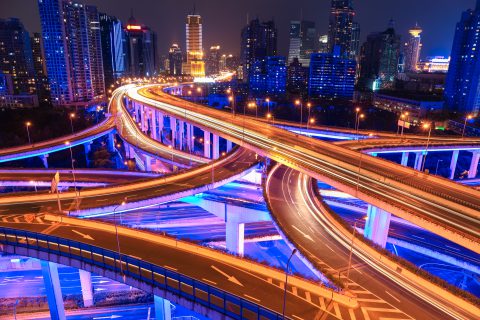Infrastructure
Transport Trends
Infrastructure posed some key questions to James Hall, senior consultant at the Johannesburg-based research and advisory firm In On Africa, regarding the key factors influencing Africa’s transport industry.
What are the key current trends affecting the transport sector?
In rail, the trend is towards electric-powered locomotives, with the new Ethiopia-to-Djibouti line the primary example, along with Kenya’s decision to make its Single Gauge Railway (SGR) electric. In sea transport, the expansion of existing ports and construction of new ports continues at all large ocean-bordered African countries. In air transport, the concept of the regional air hub (Joburg, Addis Ababa, Nairobi, Lagos) is growing obsolete as new aircraft allow profitable flights to smaller cities. The newer planes also permit intra-Africa air travel, sparing travellers having to reach one African capital from another via a connecting flight in Europe. In terms of financing, China’s model of using Africa as a means to give business to its construction firms by tying their firms’ employment to infrastructure loans to African countries is being challenged for the first time by some African countries that prefer firms from other nations doing particular work.
How important is the need for transport infrastructure development to support emerging markets in Africa?
African economies are export-driven, and goods and raw materials are going nowhere without transport infrastructure. The opening of Mozambique’s liquid national gas deposits are being made possible and production has commenced because of new road and rail infrastructure leading to ports, which themselves have been upgraded to move liquefied natural gas shipments. Ethiopia’s growing ties with Djibouti are based on landlocked Ethiopia’s need to export and import, and Djibouti was selected as the preferred country to use for sea access. Landlocked Rwanda is counting on air transportation to further boost its growing economy. South Africa’s diversified economy, which is Africa’s largest, is founded on an equally diverse transportation infrastructure. Where transport infrastructure is primarily dedicated to moving one kind of shipment, like oil in Angola, economic diversification is more difficult to achieve.
Describe the current state of Africa’s transport infrastructure?
Africa may be a laggard in some respects, but it is not a dullard. Sophisticated infrastructure initiatives of developed-world standards are widespread as Africa catches up to other continents. Considering the key transportation issues sector by sector, the inability of African countries to embrace the Treaty on Open Skies to which they are signatories is hindering the growth of air transport and keeping fares high. Rail expansion is moving forward in virtually all countries, with an emphasis on freight. Inter-urban public transport has seen advances, such as the bus lines of Addis Ababa, Cape Town and Dar es Salaam, and the continuing expansion of Joburg’s Gautrain. Innovations are taking place with the introduction of electric cars in South Africa and air delivery drones in Rwanda. China and other foreign investors are striking deals with governments that call for transport infrastructure to be in place as a condition for investment. This has added impetus to the growth of road and rail systems. Progress is uneven, however, from South Africa’s advanced infrastructure to negative infrastructure in Libya and South Sudan, whose systems are imploding due to warfare. At least Somalia has a national government in place, and can start rebuilding. Infrastructure development in the Central African Republic (CAR) and the Democratic Republic of the Congo (DRC) is stalled because of conflict.
The use of the Gautrain rail system in South Africa has had a considerable impact on transportation between the major cities of Pretoria and Johannesburg, carrying an estimated 60 000 passengers daily. Planned expansion of the network will see a total of 19 new stations that will traverse Gauteng.
Highlight some of the large-scale transport-related projects currently under way in Africa?
Mozambique’s main port at Maputo started receiving the world’s largest ships last year after dredging and expansion, and in May 2018 Kenya’s main port at Mombasa welcomed its largest ship ever after an expensive dredging of the Kilindi channel. In South Africa, the Port of East London on 9 May docked its largest ship ever – a colossal 200m-long car carrier which also carried nearly 600 passengers. The widening of the Suez Canal has come just as the East African port capacity expansion is taking place. Port expansions have been announced or are under way in Ghana, Kenya and Nigeria. Kenya’s Single Gauge Railway opened in 2017 and continues to expand, as does Ethiopia’s rail line to Djibouti which opened late last year. The new 251km highway between Dodoma and Babati in Tanzania allows travellers to and from Kenya to undergo customs at just one border post, at Namanga, speeding up travel and reducing costs. The highway is just one piece of the ultimate 10 228km TransAfrican (Cape to Cairo) Highway.
What sustainable funding options are available for transport infrastructure?
Africa must spend between $130-million and $180m yearly to maintain existing and build new and needed infrastructure, the African Development Bank has determined. The financial burden varies between countries, but generally most countries are unable to finance infrastructure development without “strings attached” loans from China in particular but also other sources that require the use of construction companies from the lending countries. One of the boasting rights politicians enjoy when announcing new highways and railroads is the number of jobs these projects offer during the building phase, and that is lessened with the use of foreign nationals. Raising money by selling government bonds is growing riskier for countries, and the International Monetary Fund has expressed alarm at the debt burden saddling African nations. Also, public works projects are huge sources of corruption, from the bribery to the kickbacks involved, which raises the cost of projects and makes financing more problematic. One answer is a multinational infrastructure fund supported by international financial institutions. The fund dispenses and monitors loans used for infrastructure projects. At the end of last year, in December 2017, the African Development Bank provided a major boost to the Emerging Africa Infrastructure Fund (EAIF) with an infusion of $100m. The EAIF is a public/private partnership company to which sub-Saharan African countries may turn to finance their infrastructure needs.
What measures have recently been implemented to improve cross-border movement and to facilitate growth in the SADC region’s economy?
In May 2018, Zimbabwe eliminated the “massive police presence” at the main border with South Africa, at Beitbridge, easing the gauntlet of bribe seekers who confronted truckers and bus drivers. Reportedly, the famously slow pace of traffic passage picked up. Now queues are longest on the SA side. In late April when Tanzania opened the 215km Dodoma-Babati Highway, one link of the TransAfrican Highway, a border post was situated at Namanga where travellers to and from Kenya will undergo a “one stop” immigration and customs regimen for both countries under a single roof. Such a facility is made possible by electronic customs clearances that have been put in place throughout Africa over the past decade, as well as new passports containing information chips. Reducing border redundancies between countries is a significant time saver and will become the standard for SADC. A single SADC and eventually African Union passport and the continuing trend of African nations dropping visa requirements for each other’s citizens will also expedite travel.
The Dodoma-Babati Highway will strengthen and increase trade within the region from the US$1.6-billion registered in 2016. The project was completed through financing assistance from the Japanese International Cooperation Agency and the African Development Bank.
Is Africa reaping the rewards of technology/intelligent transport systems?
African port authorities are cognisant of self-sailing cargo ships, and self-driving railway engine technology is understood by African railway companies. Similarly, most governments have contemplated the impact of self-driving cars on the roads. There’s awareness that the burden of testing and perfecting these technologies rests with Europe and the US, and regulations and their laws put in place to oversee the operations of these technologies will be the templates for African laws and regulations. The advancement of electric car technology depends not only on the availability of designated car plug-in points, like the ones BMW introduced in South Africa in 2016, but also reliable electricity supplies. Beyond electronic technology there are other technological improvements pioneered elsewhere but now being introduced into Africa, from Ethiopia’s smart parking structure that uses lifts to raise cars and is controlled by customers’ smart phones and debit cards, to high cube shipping containers (causing consternation with road regulators in South Africa now) and trucks that self-load and offload with built-in cranes.







 Sign-up and receive the Business Media MAGS newsletter OR SA Mining newsletter straight to your inbox.
Sign-up and receive the Business Media MAGS newsletter OR SA Mining newsletter straight to your inbox.